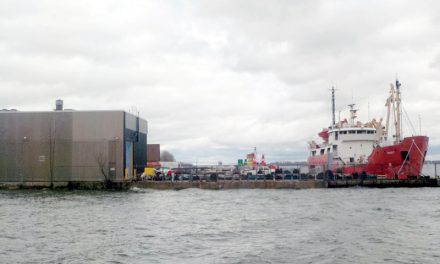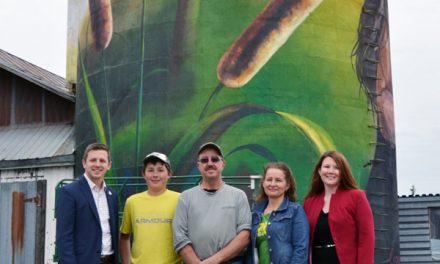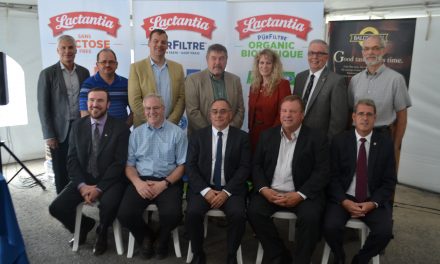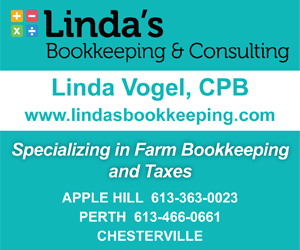Frank Haasen told the story of his recovery from a devastating fire on his dairy farm at the Eastern Ontario Dairy Days, held Feb. 13 at the North Grenville Municipal Centre. Morin photo

Courtesy photo
by Joseph Morin
AgriNews Staff Writer
KEMPTVILLE – Farming, like any other business, has a number of challenges waiting to rise up and confront it.
One session at Eastern Ontario Dairy Days brought that message home. A dairy farmer recounted how his family and business survived the catastrophe of having one of his dairy barns and milking facilities destroyed in a fire.
Held Feb. 13 at the North Grenville Municipal Centre, Eastern Ontario Dairy Days featured interesting presentations related to various sectors of the dairy industry.
One session about farm insurance was followed by Frank Haasen’s story about how he and his family dealt with the fire and how his relationship with his insurance company, neighbours, friends and bank helped to make the experience one of opportunity.

An aerial view of the Haasen dairy farm after a devastating fire in Nov. 2011. Haasen shared his lessons learned with the audience at Eastern Ontario Dairy Days.
Courtesy photo
Haasen is a partner in Haasen Farms Ltd. of Timmins, Ont.
The dairy farm was established in 1958 by his parents John and Dina Haasen.
The farm is operated today by Frank, his wife Ivy, son Eddy and employee Adam Bussier.
In November 2011 their facility was destroyed by a fire caused by a straw chopper; the theory is that a piece of stone in the chopper caused a spark to ignite nearby stacks of straw.
About 30 dairy cows, mostly calves, were lost in the fire, as was the building and all of the equipment in it.
Haasen said that while the fire department was fantastic and worked very hard to put out the fire, he had help from a neighbour who had a backhoe and that helped immeasurably.
“If you are lucky enough to have a piece of heavy equipment on the farm when you have a fire it can do more to help you; there are not enough fire fighters, not enough water,” he said.
Haasen had a lighthearted comment about the cause of the fire. Initially it was thought to be electrical in origin but later that was disproved. A friend of his who is an electrician said it’s always an electrical problem that causes the fire – never the plumber. That gave the audience a laugh.
Haasen explained how his father, at 88 years old, had to watch his entire life go up in smoke.
He reminded his audience that the first thing you must do in the case of a fire is to call 911, then “you have to call your team together and call your neighbours. Make sure you have the people around you that you want there.”
He said, “During the fire there is an awful lot going on. This is part of your life. It is hard to keep track of everyone. Empower someone to make decisions,” he said.
He pointed to a photograph of a few calves on the screen.
“These are probably the only livestock saved from the calf barn,” he said. “When we got in the barn there were flaming straw bales dropping down into the barn. We decided to save other cattle and minimize the human risk.”
Once as many animals as possible had been saved, he had to think about having them milked immediately. “I called a few key people, including our regular cattle buyer and two or three other friends who might be able to move those cattle in the morning,” he said.
“We also called our insurance adjuster who sent out an adjuster that night.”
The key to their recovery was taking what action they could as soon as possible. By morning the fire was out and 80 cows were moved by small trailers to farms in the Earlton area. “Some only took two, none took more than six and only two had to make two trips,” said Haasen.
By now the insurance adjuster had arrived and an investigation into the fire was started. “The adjuster interviewed all of our team.”
Haasen said another action they took the day after the fire was to call their lender and their DFO, FSR and milk transporter.
Haasen stressed the need to work closely with the insurance adjuster. He pointed out that from the day of the fire until the claim was finally closed, he maintained a good relationship with the insurance company. Still, it took more than a year to sort the claim out. “We received our last cheque from the insurance company in May of 2013.”
The Timmins Fire Department felt the fire was an accident and further investigations by the insurance company agreed; rebuilding could begin.
Retire or rebuild
The fire was a time for Haasen’s family to wonder if it was time to retire.
Hassen knew that a rebuild would usually mean spending more money. He decided it was worth moving forward. He jokingly told the crowd at Dairy Days, “The rebuild of your dreams, bigger, better and broke(r).”
After deciding to rebuild, the first step was to come up with a good business plan. The Haasens visited other farms, got in touch with contractors and did their research. They decided they would move to a robotic miking system.
After sifting through who they felt would be best for the job and selecting a contractor, as well as getting all of the required municipal and provincial permits, the rebuild began.
Construction started in early June 2012. By that August the barn was starting to look like a barn.
Looking back on the experience, Haasen said, “What went well was the great support from friends, family and the community.”
He added, “The insurance company and adjuster treated us fairly but having patience was important.”
He said all of the suppliers and contractors were great to work with, however to ensure that the relationship stayed good, he paid everyone promptly.
What did not work out so well was the death rate for all of the cows that had to be shipped off to neighbours or other farms.
“We also realized the old dairy barn was not as good a heifer facility as we thought,” he said.
Looking at the situation with 20/20 hindsight, Haasen said he would consider keeping all of his cattle – from calves to milking herd – all under one roof. Another decision he would have made was selling all bred heifers, milking and dry cows as soon as possible after such an event.
The right coverage is critical
He warned his audience that having the right kind of replacement insurance was key to recovering for something like a fire. He said the cost of many items he had to replace had risen significantly since they were first purchased.
Haasen also noted that business interruption coverage was crucial. “With business interruption coverage, a business owner can collect the income he or she would have expected to generate were it not for the unexpected event.”
He said he had to go through a forensic audit to justify he deserved to collect his coverage and the insurance company gave him 100 per cent.
In the end Haasen said, they survived.
“A fire is a disaster that turns into a challenge and opportunity,” he said.













